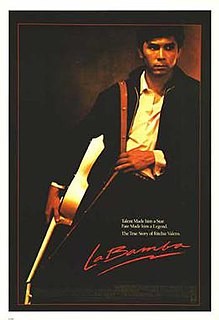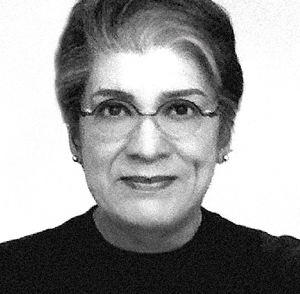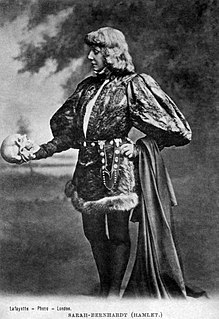
La Bamba is a 1987 American biographical film written and directed by Luis Valdez that follows the life and career of Chicano rock 'n' roll star Ritchie Valens. The film stars Lou Diamond Phillips as Valens, Esai Morales, Rosanna DeSoto, Elizabeth Peña, Danielle von Zerneck, and Joe Pantoliano. The film depicts the impact Valens' career had on the lives of his half-brother Bob Morales, his girlfriend Donna Ludwig and the rest of his family.

The corrido is a popular narrative song and poetry that form a ballad. The songs are often about oppression, history, daily life for peasants, and other socially relevant topics. It is still a popular form today in Mexico and was widely popular during the Mexican Revolutions of the 20th century. The corrido derives largely from the romance, and in its most known form consists of a salutation from the singer and prologue to the story, the story itself, and a moral and farewell from the singer.
Lucille Corinne Templeton, better known as "Rini" Templeton, was an American graphic artist, sculptor, and political activist. She was most active in Mexico and the Southwestern United States, although she also volunteered in Cuba and Nicaragua after the triumph of the Cuban Revolution and the electoral victory of the F.S.L.N. Although her name is not well known, her uncredited work has been used on countless fliers, posters, and banners for the labor, feminist, and social justice movements.

Carlos Almaraz was a Mexican-American artist and an early proponent of the Chicano street arts movement.

The Centro Cultural de la Raza is a non-profit organization with the specific mission to create, preserve, promote and educate about Chicano, Mexicano, Native American and Latino art and culture. It is located in Balboa Park in San Diego, California.The cultural center supports and encourages the creative expression “of the indigenous cultures of the Americas.” It is currently a member of the American Alliance of Museums.

California Ethnic and Multicultural Archives (CEMA) is an archival institution that houses collections of primary source documents from the history of minority ethnic groups in California. The documents, which include manuscripts, slide photographs, newspaper clippings, works of art, journals, film, sound recordings, and other ephemera, are housed in the special collections department of the UCSB Libraries at the University of California, Santa Barbara, where they are made accessible to researchers upon request. An effort is currently underway to make certain documents available online through the Online Archive of California.

Juan Felipe Herrera is a poet, performer, writer, cartoonist, teacher, and activist. Herrera was the 21st United States Poet Laureate from 2015 to 2017.
Los Vendidos is a one-act play by Chicano playwright Luis Valdez, a founding member of El Teatro Campesino. He wrote it in 1967, and it was first performed at the Brown Beret junta in Elysian Park, East Los Angeles. The play examines stereotypes of Latinos in California and how they are treated by local, state, and federal governments.
Diane Rodriguez is a prominent American theatre artist who directs, writes and performs. An OBIE Award winning actor, she is known for using comedy to confront various forms of oppression, often with special attention to issues of gender and sexuality.
Luis Alfaro is a Chicano performance artist, writer, theater director, and social activist.

Pineros y Campesinos Unidos del Noroeste, more commonly known by the acronym PCUN, is the largest Latino union in the state of Oregon. PCUN is located in Woodburn, Oregon. According to the Statesman Journal, the meetings which led to the formation of PCUN were held at Colegio Cesar Chavez, the nation's first fully accredited and independent Latino college. PCUN was founded in 1977 by Cipriano Ferrel, who graduated from Colegio Cesar Chavez and worked closely with Cesar Chavez himself. Ferrel was motivated to create the organization after an increase in immigration raids in Oregon.PCUN has organized the creation of migrant housing and farmworker housing. Cipriano Ferrel worked closely with Cesar Chavez.

Judithe Hernández is a Los Angeles–based artist whose career began as a founding member of the Chicano Art/Los Angeles Mural movements. She first received acclaim in the 1970s as a muralist. In her long career as a studio artist her artistic practice as centered on works-on-paper, principally pastels, which frequently incorporate indigenist imagery and the social-political tension of gender roles. Hernández has lived both in Chicago, Illinois and Los Angeles. In 1974, she became the fifth member, and only woman, in Los Four, the influential and celebrated East Los Angeles Chicano artist collective, along with Carlos Almaraz, Frank E. Romero, Robert de la Rocha, and Gilbert Luján. As early as 1970, Hernández was involved in the initial efforts of Chicano artists in East Los Angeles to organize. Of this experience, Hernández later said that "Often I was literally the only female at meetings who was not a girlfriend or wife, but an active artist participant."
Joseph Julián González is an American composer based in Los Angeles, California. Working primarily as a composer for television and film, he also composes for live orchestra and choir performance.
Daniel "Danny" Valdez is an American actor, musician, composer and activist. He is best known for his work as musical director of the films Zoot Suit (1981) and La Bamba (1987).
Richard Montoya is a Chicano actor, director, producer, screenwriter, playwright, comedian, and co-founding member of the San Francisco based performance troupe Culture Clash. His work in theatre is largely comedy-based and centers around ideas of racism, immigration, discrimination, and identity in Latin-American communities. He follows in the steps of his father, famous activist José Montoya, and is known for creating social and political change through a variety of artistic expressions.
Anthony J. Garcia (1953), known as Tony Garcia, is a playwright and the current Executive Artistic Director of Su Teatro in Denver, Colorado. He has written over 20 original plays and has served as Su Teatro's artistic director since 1989.
El Malcriado was a Chicano/a labor newspaper that ran between 1964 and 1976. It was established by the Chicano labor leader Cesar Chavez as the unofficial newspaper of the United Farm Workers during the Chicano/a Movement of the 1960s and early 1970s. Published in both English and Spanish editions, El Malcriado provided a forum for migrant workers to criticize working conditions and served as a way to organize the collective voice of Mexican American farmworkers. The newspaper's contents ranged from articles on union activities, coverage of labor issues, political commentary, cartoons, satire, and artwork. It is an example of ethnic press or alternative media that developed from political movements and immigrant communities within the United States in order to challenge the existing power structure and gain political leverage.
Jorge Alfonso Huerta is a Chicano scholar, author, and theater director. He specializes in Chicano and United States Latinx Theatre. He has written and edited several books specializing in Chicano theatre, and is considered to be an authoritative expert in his field.
Jacob Padrón is a Mexican-American artistic director. He has founded several theater companies with the intent to promote and bring visibility to latino/a artists and theatre.



















